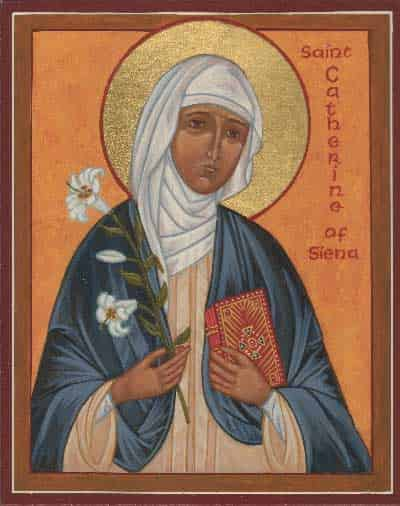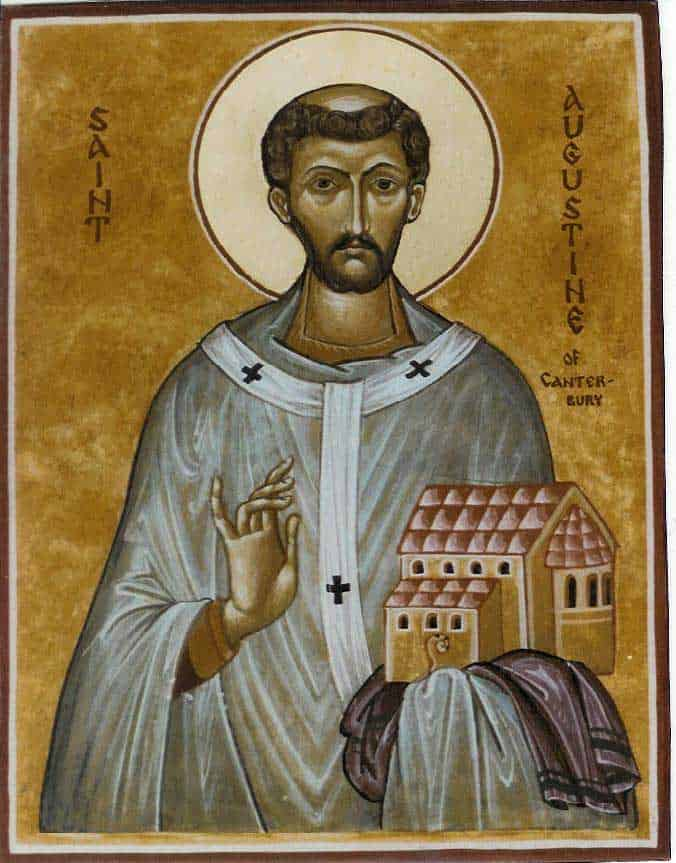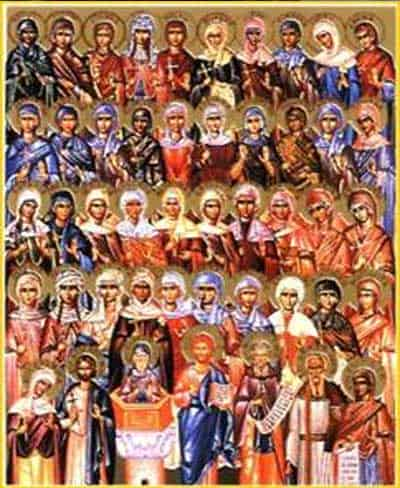Saint Catherine of Siena Catholic Saint
CATHOLIC SAINTS 28-12-2023, 19:39

Saint Catherine of Siena
Catholic Saint
st.Catherine of Siena-Doctor of the Church and second woman to be so named
Feast Day : April 29
Patronage: the dying; fire prevention; nursing homes; spinsters; Italy (since 1939); Rome (since 1866)
Catherine of Siena was born on March 25, 1347, in Siena, Italy, the youngest of 25 children in the Benincasa family. Her father, Giacomo di Benincasa, was a dyer; her mother, Lapa, the daughter of a local poet. From her earliest childhood Catherine saw visions and practiced extreme austerities; she wore a hair shirt. When she was five, it was said that angels levitated her up and down stairs, so pleased were they with her “Hail Mary” prayers. At age six, she had a remarkable vision of Jesus giving her a benediction, which took place while she was traveling on a road with an older brother. At the age of seven she consecrated her virginity to Christ. At 16, she took the habit of the Dominican Tertiaries. For three years she engaged in celestial visitations and familiar conversation with Christ. In 1366 she had a profound mystical experience of spiritual marriage.
For a long time preceding, she had been advised of this by Jesus speaking in her interior voice. On the last day of Carnival, the voice told her, “I will this day celebrate solemnly with thee the feast of the betrothal of thy soul, and even as I promised I will espouse thee to Myself in faith.” While Jesus spoke, there appeared a glorious vision of Jesus, the Blessed Virgin Mary, St. John the Evangelist, St. Paul and St. Dominic, along with the prophet David, who played the psaltery set to music. Mary took Catherine’s right hand and held out its fingers to Jesus, asking him to espouse himself to Catherine in faith. Jesus drew out a gold ring set with an exquisite diamond encircled with four pearls and placed it on the ring finger of Catherine’s right hand. He said, “Lo, I espouse thee to myself, thy Creator and Savior in the faith, which until thou dost celebrate thy eternal nuptials with me in Heaven thou will preserve ever without stain. Henceforth, my daughter, do manfully and without hesitation those things by which the ordering of My providence will be put into thy hands; for being now armed with the fortitude of the faith, now will happily overcome all thy adversaries.” The vision disappeared. For the rest of her life, Catherine could see the ring upon her finger, though it was invisible to others.
(Similarly, St. Teresa of Avila was given by Jesus a rosary made of “stones more precious than diamonds.” It, too, was visible only to her.) Catherine experienced other mystical gifts, including levitation during prayer, multiplication of food and the ability to smell the stench of sin in others. She performed miraculous healings and relieved others of diabolical possession. Supernatural rays of light issued forth from her face. She endured mystical fasts. In 1370, she was said to raise her mother, Lapa, from the dead after her mother died suddenly. Once she fell into an ecstasy in which Jesus approached her holding a red human heart. He opened her left side and placed the heart inside, saying, “Dearest daughter, as I took your heart away, now, you see, I am giving you Mine, so that you can go on living with it forever.” The heart was said to make loud noises of joy whenever Catherine was happy. Catherine’s peers resented her supernatural gifts and brought charges against her. She was cleared of charges and given a spiritual director, Bl. Raymond of Capua, who became her first biographer. Catherine returned to Siena, and began to tend the sick (especially lepers and plague victims), help the poor and convert sinners. She suffered terrible physical pain, but forced herself to live for long periods on little food save the Blessed Sacrament. Nonetheless, she charmed everyone with her happiness, wisdom and spiritual insight, and was sought as a counselor and peacemaker. She gathered disciples. During the summer of 1370 she received a series of special manifestations of Divine mysteries, which culminated in a prolonged trance, a kind of mystical death. She had a vision of hell, purgatory and heaven, and heard a Divine command to leave her cell and enter the public life of the world. From this trance, Catherine produced her great mystical work, The Dialogue of the Seraphic Virgin Catherine of Siena.
She also began to dispatch hundreds of letters to men and women, including the princes and nobility of the republics of Italy, and papal legates. She was consulted about the affairs of the Church, and counseled Pope Gregory XI (r. 1370–78) on numerous matters, including his plans for a crusade against the Turks, and for reforming the clergy and the administration of the Papal States. On a visit to Pisa in 1375, Catherine received the stigmata on the fourth Sunday of Lent. Praying before a crucifix, Catherine saw five rays of blood come from the points of the wounds to her, changing into rays of light as they reached her body. She prayed that the marks would not be visible to others as long as she lived; they appeared after her death. She said the five wounds did not pain her but strengthened her. Gregory sent her to Avignon as a peace ambassador of the Florentines when war broke out between Florence and the Holy See, but she was unsuccessful. However, she impressed Gregory so much that he took her advice to return the papacy to Rome in 1377. In 1378 Gregory dispatched her again to Florence, where an attempt was made to murder her.
Gregory died and was succeeded by Urban VI (r. 1378–89). She remained in Florence until peace was declared, and then returned to Siena. Urban’s election resulted in the Great Schism and the election of an antipope, Clement VII. Catherine supported Urban VI, and was summoned to Rome by him in November 1378. She remained in Rome for the rest of her life, working for the reformation of the Church, serving the sick and poor, and dispatching eloquent letters in behalf of Urban (she had miraculously learned how to write herself in 1377 and no longer had to rely on dictation). Her last political work, accomplished practically from her deathbed, was the reconciliation of Pope Urban VI with the Roman Republic. In 1380 her health began to fail and Catherine prayed to join Christ. She could scarcely swallow due to severe inflammation in her throat. On Sexagesima Sunday, she suffered a violent stroke, followed by another one the next evening. Nonetheless, she rose every day during most of Lent and walked a mile to St. Peter’s, where she prayed all day. Finally, overcome, she lay in bed for eight weeks, covered with sores and unable to lift her head. Her body wasted away. In her final hours, she rallied to berate herself for her imperfections and sins, and to pray for the Church, the pope and others. She asked for, and received, plenary indulgence to be absolved of all her sins, saying it had been granted to her by Popes Gregory and Urban.
Catherine died at age 33 on April 29, the Sunday before the Ascension. Her body was displayed for three days and remained intact, flexible and fragrant. Huge crowds came to touch her corpse. Catherine was buried in the cemetery of the Church of Santa Maria sopra Minerva, and soon was moved to the foot of a column facing the Rosary Chapel, where she remained until 1430. However, in 1385 her head was severed, placed in a gilded copper reliquary and secretly sent to Siena, where it eventually was placed in the Hospital of St. Lazarus, where she had ministered the sick. Other relics taken from the body at the same time were an arm for Siena and three fingers for Venice. In 1430, what remained of the body was placed in a new stone sarcophagus. It was opened from time to time for the taking of more relics for Dominicans throughout Europe, including: a hand taken in 1487 for the Dominican Sisters of the Monastery of S. Domenico et Sisto in Rome; the left foot, bearing stigmata, taken in 1487 for the Church of SS. John and Paul in Venice; a rib taken in 1501 for the convent of St. Mark in Florence; a shoulder blade taken in 1575 for the Dominican Sisters of Magnanapoli in Rome; two reliquaries of bone and skin taken in 1855 for St. Dominic’s in Stone, England, and the convent of St. Catherine in Bow, England. The finger that bore the mystical ring of Christ was given to the Chartreuse of Pontiniano near Florence. Other small relics were distributed as well. On August 4, 1855, the sarcophagus of Catherine was placed below the main altar of the Church of Santa Maria sopra Minerva. This event is known as the Translation of the Relics of St. Catherine, which feast is commemorated on the Thursday after Sexagesima Sunday. The feast of her Espousals is kept on the Thursday of the carnival.
Besides her Dialogue, Catherine’s body of work includes more than 400 letters and a collection of prayers. Her writings are considered to be among the classics of the Italian language. The Dialogue comprises four treatises, on divine providence, discretion, prayer and obedience. Its style “bears upon it all the marks of true automatic composition of the highest type,” according to mysticism expert Evelyn Underhill. Central to Catherine’s teaching is that man, whether in the cloister or in the world, must always abide by “the cell of self-knowledge,” through which one comes into perfect knowledge of God: “In self-knowledge, then, thou wilt humble thyself; seeing that, in thyself, thou dost not even exist.” Catherine is invoked against headaches and the plague. In art she is depicted in her Dominican Tertiary clothing. Her emblems are the lily and book, the crown of thorns, or sometimes a heart, referring to the legend of her having changed hearts with Christ. She is the second woman after St. Teresa of Avila to be named a Doctor of the Church, and one of only three women to hold the honor.

st.Augustine of Canterbury Patronage: England Also known as: Austin Augustine was by all accounts a timid...
Learn more
Do the Devil and Demons Really Exist? The story of job tells how Satan asked God for a chance to test Job...
Learn more
Bible Quotes Proverbs 3:6 Mobile Wallpaper Christian mobile wallpapers Proverbs 3:6 In all your ways...
Learn more


